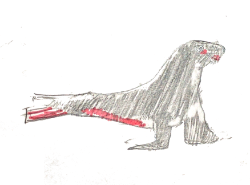 PENGUINS SEA-LIONS BIG CATS |
| Home | Participants |
Organisers |
Schedule |
Context |
Links and
Downloads |
|
Enrichment for sea lions at ZooJam 2016 from Fiona French on Vimeo. |
Sea Lion Brainstorm
Link swimming with foraging, cognitive link between action and result = emotional feedback Launch fish into current to give “life”, trigger food when sea lions have done enough work. And give them enough food to satisfy so they can relax. How to provide more control over food supply, so not keeper focused Training issue – always hungry = chronic frustration Discussion point: How to manage public expectations Pin to welfare “countdown” for sea lions, come back later when they’ve swum enough to trigger the sardine dispenser – real-time feedback for visitors – animals have swum X km today. If not swimming also provides health data. Sea Lion BriefSEA LIONS (Matt O’Leary – keeper at ZSL)Wild Californian sea lions are dynamic hunters and will use fast paced movement using their flippers to propel them through water at high speed to catch prey. In captivity, Californian sea lions are historically used for public demonstrations and are highly trainable. Although positive reinforcement training can be enriching to the animal, the majority of food comes from a keepers/trainer hand during these training sessions which restricts the amount of natural foraging behaviours in captivity. Due to this, sea lions can become overly focused on their keepers and can react in anticipation of food when they see or hear a keeper. Wild sea lions can spend multiple hours foraging for food at sea whereas in captivity during training sessions time spend feeding is considerably less. Even when not being trained, feeding is a short time event. Goal To promote natural foraging behaviour To increase time spend foraging To reduce keeper focus for food   
|